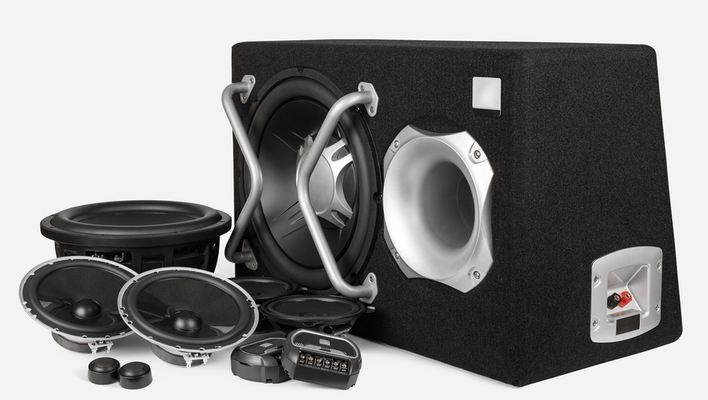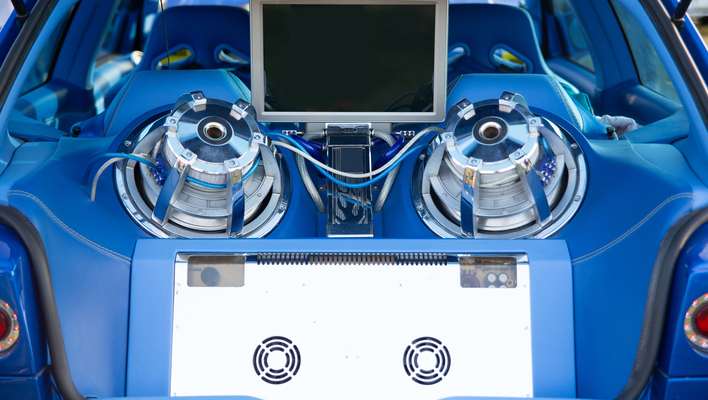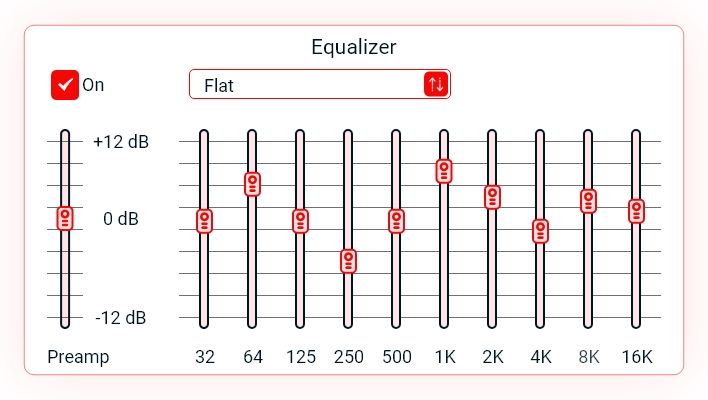No amp for your sub? Amplifiers provide the extra juice your system needs to produce a louder sound. Here’s how to connect subwoofer to car stereo without amp.
Subwoofers are usually accompanied by an amplifier. As the name suggests, the amplifier increases the strength of a weak audio signal from the source (head unit, music player, etc) into a stronger signal for the subwoofer. Unfortunately, not everyone can acquire a top-quality amplifier for the job. In this article, Audio Curious shares tested tips on how to connect subwoofer to car stereo without amp.
Fortunately, there is a way to hook up your sub to the car stereo without an amplifier and still get good music. Although the music loudness and quality might sound degraded to some extent, it is still worth trying to learn how to hook up a subwoofer without an amp if getting an amplifier is out the window. This article provides a detailed guide on how to connect subwoofer to car stereo without amp.
Step 1: Check Your Subwoofer
Technically speaking, you can’t just plug your subs in the stereo and expect them to work as they normally would with an amplifier. Subwoofers have huge magnets and cones that require some serious power to drive. So, How do you hook up a subwoofer without an amp? You need to check the subwoofer model first and ensure it fits perfectly in the space allocated inside the vehicle.
Several types of subwoofers exist, ranging from spare wheel subs, bass tubes, under seat subs, and many others. All these models fall into two categories; active and passive subwoofers.

a. Active Subwoofer
An active sub is one with an in-built amplifier. It is a self-contained unit whereby the speaker and amplifier work in harmony to enrich your lows. Active subwoofers often come as a single unit. The amplifier and subwoofer are contained in one housing. This setup minimizes the head unit and receiver load by leaving them to handle the mid-range and high frequencies.
b. Passive Subwoofer
A passive sub does not have an amplifier built in it. Instead, it uses an external amplifier to provide extra power for the lower frequencies. Passive subs demand lots of energy from the external amp. And since yours will most likely work with a single amplifier, you need to provide an amp that produces sufficient power.
The main difference between active and passive subs is the presence or absence of the amp. Passive subs also usually come in smaller compartments than active subs. This makes them the better option in smaller cars. On the other hand, active subwoofers come in larger enclosures that can be placed anywhere inside the vehicle, e.g. under the seat.
Most people love passive subs because they can outperform active subwoofers, provided that they are accompanied by a high-quality amplifier
.
Step 2: Find the Ideal Spot For Your Subwoofer

Before learning how to connect a subwoofer to a car stereo with an amp, it would be advisable to find a good mounting location for your subwoofer. Finding a suitable spot depends on the space available, subwoofer performance, and where you want to place it.
In other words, you should place your subs where they sound great and where you’d like them to be. For instance, many car owners have found that their subwoofers produce great sound when placed in the trunk or behind the back seat.
If you can’t seem to find the sweet spot, try moving your subwoofer around the car and listen. Different car shapes affect the quality of sound, and so do the inner vehicle’s fabrics. Moving the sub around before settling on one location reveals where it performs its best.
Step 3: Install The Subwoofer
This step requires some basic knowledge about electrical circuits. That is why experts urge that you should start every installation procedure by reading the owner’s manual for proper wiring. Going through the manual reveals critical details about your stereo and sub, including the total load you’re up against, where to hook up the wires to avoid reversed polarities, among other issues.
When installing your subwoofer without an amp, you’re going to have to connect subwoofer to rear speakers. The idea is to yank out the rear speaker cables and bridge the channel outputs into one massive voltage capable of driving the subwoofer.
Unlike original amplifier installation, the procedure is quite easy to follow since you’re not doing many dashboard alterations or tapping new wires into the car’s battery. However, you still need to disconnect the battery completely and remove other delicate electrical components as a safety precaution.
And sadly, the circuitry in the head unit alone is not enough to drive your massive subwoofer cones, so you should not expect the normal performance you would get from using an amplifier. To install subwoofer without amp:
- First, unmount the rear speakers to get access to the wiring. Disconnect the wires that run to your rear left and rear right speakers. Remember, you will no longer be able to use these speakers at the same time with your subwoofer since the connection will be severed.
- Next, locate the subwoofer terminals (normally found at the back of the sub). Connect the subwoofer’s positive wire to the rear left speaker and the negative wire to the right rear speaker wire. Remember, you won’t have as much power as you would with an amp. For this reason, experts at Audio Curious recommend using only one subwoofer.
- If your subwoofer has no speaker wires, you’ll have to draw the power from the wiring harness located in the head unit. Unmount the head unit and get access to its wiring. Your sub needs a power source, and since the battery or amplifier is not an option at the moment, you’ll need to add an adapter. The adapter acts as your ultimate power source.
If you have an active powered subwoofer, there is no need to apply the above method. All you have to do is connect it with the stock stereo through a jack wire and enjoy your music. However, you’ll have to tap into the battery and run a power cable to the subwoofer’s location.
Next, you need to unmount the head unit to get access to the wiring harness. Connect the subwoofer to the stereo through RCA cables using all measures to find and fix car speaker distortion. Ensure that all the connections are firmly held in place to avoid further distortion and electric interference.
Step 4: Obtain Appropriate EQ Settings
DIY audio often tends to get sloppy at first. Even without an amplifier to power up your subwoofer, you might still encounter issues such as distortion, hissing, crackling, and interference. That is why you need to experiment with different equalizer settings on the head unit.

How to Tune Your Equalizer
If your car stereo has equalizers for tuning your radio, it’s time to take advantage of them. Tuning the system alters the sound quality. You might have to use advanced equipment or basic hearing to point out any issues.
How can I get bass without an amp? Prepare the sub by adjusting the equalizers. Basic EQ settings cover 3 bands; low, mid, and high frequencies. More complex EQs offer greater control using 13 instead of 3 frequency bands.
Using a Spectrum Real-Time Analyzer
You can use a Real-Time Analyzer (RTA) tool to check the audio quality in your car. You can easily tweak and adjust your EQ settings until you get smooth curves on the graph displayed by playing a wide range of frequencies while running the app. Basic EQs present a challenge since they only give you control over large frequency gaps. But with a more advanced equalizer, you get much more control over the frequency bands and match the speakers more effectively.
Manual Tuning
In this method, turn on your stereo and play your favorite song. Take note of how it sounds without altering the settings. If anything goes wrong in the tuning process, these settings will become your default settings.
If your subwoofer has some in-built crossover settings, adjust the crossovers till you hear clear bass notes. Finally, listen to your song once more and see if you can pick up any issues. Without an amplifier, equalizers are your closest friend if you want to enjoy good bass. Adjusting the equalizers gets rid of the huge peaks and dips. It also eliminates harsh sounds.

Step 5: Get The Professional Installers (If Need Arises)
There is no shame in admitting defeat. Some car stereos are more complicated than others, meaning that learning how to install a subwoofer in a car without an amp is not always straightforward. Others encounter unexpected yet complex issues.
In case you face such problems, hire expert installers. Professional installers can help you save money and time since they have the right tools and skills for the job. In addition, they take away the bigger burden from your shoulders. You won’t have to buy expensive tools for the job since professionals come with their own.
Also Read: Tips on How to Increase Bass in a Subwoofer Box
Final Thoughts
Connecting subwoofer to car stereo without amp may not yield the expected results due to the absence of the amp. However, if you can’t install an amplifier, doing without it presents an opportunity to enjoy your music.
